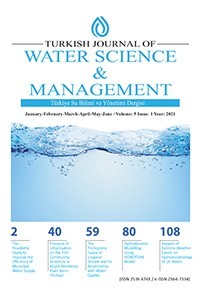Amerika Birleşik Devletleri’ndeki Minimum Akım Trendleri
Low Streamflow Trends in the United States
low streamflow trend analysis, streamflow,
___
- A tutorial on Principal Components Analysis Lindsay I Smith February 26, 2002.
- Anctil, F., and Paulin, C. (2003). Wavelet Analysis of the Interannual Variability in Southern Que´bec Streamflow. 2004 American Meteorological Society.
- Burn, D.H., and Hag Elnur, M.A. (2002). "Detection of hydrologic trends and variability." Journal of Hydrology 255(1–4): 107-122.
- Clausen, B., I.G. Jowett, B.J.F. Biggs, and B. Moeslund, (2004). Stream Ecology and Flow Management. In: Developments in Water Science 48, L.M. Tallaksen and H.A.J. Van Lanen (Editors). Elsevier, Amsterdam.
- Curran, C.A., Eng K., and Konrad, C.P. (2012). Analysis of low flows and selected methods for estimating low-flow characteristics at partial-record and ungaged stream sites in western Washington: U.S. Geological Survey Scientific Investigations Report 2012-5078.
- Helsel D.R, and Hirsch, R.M, Statistical Methods in Water Resources. Techniques of Water-Resources Investigations of the United States Geological Survey.
- Dai, A. (2013). "Increasing drought under global warming in observations and models." Nature Clim. Change 3(1): 52-58.
- Douglas, E. M., et al. (2000). "Trends in floods and low flows in the United States: impact of spatial correlation." Journal of Hydrology 240(1–2): 90-105.
- EPA Water Data & Tools. Retrieved from http://water.epa.gov/scitech/datait/models/dflow/flow101.cfm
- Flynn, R.H., (2003). Development of regression equations to estimate flow durations and low-flow frequency statistics in New Hampshire streams: U.S. Geological Survey Water- Resources Investigations Report 02.
- Imperial College London, DOC493: Intelligent Data Analysis and Probabilistic Inference Lecture 15.
- IPCC (2001) Third Assessment Report. Working Group II: Impacts, Adaptation and Vulnerability; Chapter 4: Hydrology and Water Resources. Retrieved from https://www.ipcc.ch/ipccreports/tar/wg2/pdf/wg2TARchap4.pdf
- James A. Falcone, United States Geological Survey, GAGES II (Geospatial Attributes of Gages for Evaluating Streamflow), summary report, September 2011.
- Kahya E., Demirel M.C., and Piechota T.C. (2007). Spatial grouping of annual streamflow patterns in Turkey. Hydrology Days 2007.
- Kahya, E. and Kalaycı, S. (2004). "Trend analysis of streamflow in Turkey." Journal of Hydrology 289(1–4): 128-144.
- Kendall, M.G. (1975). Rank correlation methods. Charles Griffin. London. McCabe GJ, Wolock DM (2002) Trends and temperature sensitivity of moisture conditions in the conterminous United States. Climate Research 20.54
- Lins, H.F. (1985). "Interannual streamflow variability in the United States based on principal components." Water Resources Research 21(5): 691-701.
- Lins, H.F. and Slack, J.R. (1999). "Streamflow trends in the United States." Geophysical Research Letters 26(2): 227-230.
- Lorenzo-Seva, U. (2013). How to report the percentage of explained common variance in exploratory factor analysis. Technical Report. Department of Psychology, Universitat Rovira i Virgili, Tarragona.
- NOAA Climate Prediction Center, Climate Teleconnections. Retrieved from http://www.cpc.ncep.noaa.gov/data/teledoc/teleintro.shtml
- Pal, I., Anderson B.T., Salvucci G.D., Gianotti D.J. (2013). Shifting seasonality and increasing frequency of precipitation in wet and dry seasons across the US. Geophysical Research Letters 40:4030-4035.
- Pal, I., Towler E., and Livneh B., (2015). How Can We Better Understand Low River Flows as Climate Changes?, Earth & Space Science News. Retrieved from https://eos.org/opinions/how-can-we-better-understand-low-river-flows-as-climate-changes
- Small, D., et al. (2006). "Trends in precipitation and streamflow in the eastern U.S.: Paradox or perception?" Geophysical Research Letters 33(3): n/a-n/a.53.
- Smakhtin, V.U. (2001). "Low flow hydrology: a review." Journal of Hydrology 240(3–4): 147-186.
- Sawaske, S.R. and Freyberg, D.L. (2014). "An analysis of trends in baseflow recession and low-flows in rain-dominated coastal streams of the pacific coast." Journal of Hydrology 519, Part A: 599-610.
- Smith, C.L., Turcotte, L.D., and Isacks, L.B. (1998). Stream flow characterization and feature detection using a discrete wavelet transform. Hydrological Processes, Vol. 12, 233±249 (1998)
- Tallaksen, L.M., and Van Lanen, H.A. (2004). Hydrological drought: processes and estimation methods for streamflow and groundwater. Elsevier 48.
- Trenberth, K. E., et al. (2014). "Global warming and changes in drought." Nature Clim. Change 4(1): 17-22.
- U.S. EPA (2012) Background information on the definition and characteristics of low flows. Flow 101. DFLOW. Retrieved from http://water.epa.gov/scitech/datait/models/dflow/flow101.cfm
- USGS GAGES-II: Geospatial Attributes of Gages for Evaluating Streamflow. Retrieved from http://water.usgs.gov/GIS/metadata/usgswrd/XML/gagesII_Sept2011.xml
- USGS Water Data FAQ. Retrieved from http://help.waterdata.usgs.gov/faq/sites/do-stationnumbers-have-any-particular-meaning.
- Westra, S., Brown, C., Lall, U., and Sharma A. (2007). Modeling multivariable hydrological series: Principal component analysis or independent component analysis?. Water Resources. Res., 43, W06429, doi:10.1029/2006WR005617.
- McCabe GJ, Wolock DM (2002) Trends and temperature sensitivity of moisture conditions in the conterminous United States. Climate Research 20.54
- ISSN: 2536-474X
- Başlangıç: 2017
- Yayıncı: Tarım ve Orman Bakanlığı Su Yönetimi Genel Müdürlüğü
Akarçay Havzası’nda Su Çerçeve Direktifine Göre İlk Biyolojik İzleme: Fitoplankton ve Fitobentoz
Nilsun DEMİR, Tolga ÇETİN, Caner GÖK, Müge ŞANAL
Amerika Birleşik Devletleri’ndeki Minimum Akım Trendleri
Kapsamlı Bir Kuraklık Yönetim Planı Oluşturulması İçin Gerekli Araçlar - Konya Havzası Çalışması
Mustafa Berk Duygu, Bilal Kirmencioğlu, Maruf Aras
İklim Değişikliğine Adaptasyon Kapsamında Sektörel Etki Analizi Metodolojisi
Maruf Aras, Ayşegül Tanık, Ayşe Yıldırım Coşgun, Seda Abat, Mehmet Aşkıner
Alternati̇f Reservuar Haci̇m Deği̇şi̇mleri̇ni̇n Taşkın Kontrolu Açısından Değerlendi̇rilmesi
Mustafa Demirel, Ralph A. Wurbs
Türkiye için İklim Değişikliği Projeksiyonları: Üç Model ve İki Senaryo
Mesut DEMİRCAN, Hüdaverdi GÜRKAN, Osman ESKİOĞLU, Hüseyin ARABACI, Mustafa COŞKUN
